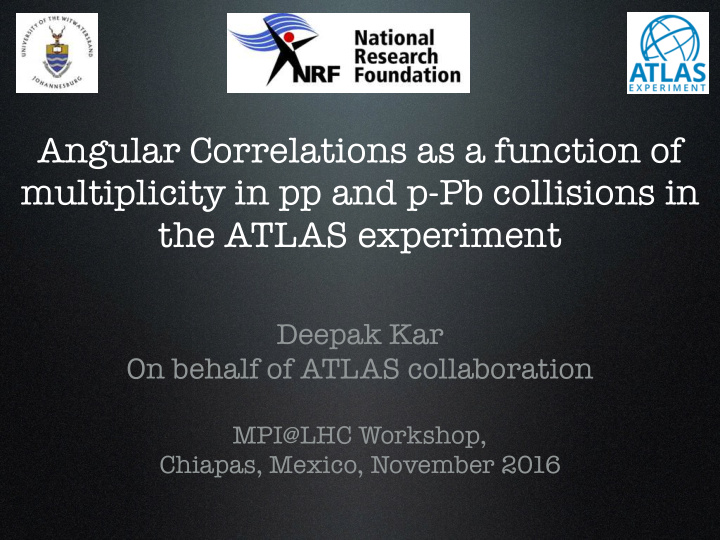



Angular Correlations as a function of multiplicity in pp and p-Pb collisions in the ATLAS experiment Deepak Kar On behalf of ATLAS collaboration MPI@LHC Workshop, Chiapas, Mexico, November 2016
Collective Behaviour in a small system ~30000 particles ~1000 particles ~100 particles Reveal collective/flow like behaviour via the two particle correlation method 2
First ATLAS 13 TeV pp Ridge Run 2 paper Recoil Jet Leading Ridge Jet In high multiplicity events there is an enhancement in the particle production at Ỏφ ≈ 0 over wide range of Ỏỷ 3 Phys. Rev. Lett. 116, 172301 (2016)
Extracting the Ridge Suppress dijet system 4 Phys. Rev. Lett. 116, 172301 (2016)
40 < N ch < 50 Enhancement of the high N ch region due to a dedicated high-multiplicity track trigger 5 Phys. Rev. Lett. 116, 172301 (2016)
60 < N ch < 70 6 Phys. Rev. Lett. 116, 172301 (2016)
N ch > 90 7 Phys. Rev. Lett. 116, 172301 (2016)
Narrowing of the distribution due to cosine component N ch > 120 8 Phys. Rev. Lett. 116, 172301 (2016)
In more Systems 9 arXiv:1609.06213
Azimuthal Correlations Characterized by Fourier coefficients to describe relative amplitudes of sinusoidal components Measured by 2 pc: Long range part subtracted by using peripheral events arXiv:1609.06213 10
Factorization? While v 2,2 values vary, v 2 agrees quite well. Similarly for p-Pb case. 11 arXiv:1609.06213
Multiparticle Cumulants Useful tool to study the global nature of correlations Cumulants: 12
Results N reftrk : Ref particles: within a narrow p T range Method 1: for a fixed N reftrk Method 2: fixed multiplicity for fluctuating N reftrk For lower ref p T range, method 2 gives smaller values, multiplicity fluctuations lead to negative contributions to cumulants 13 ATLAS-CONF-2016-106
Comparison with MC As compared to the data, Pythia 8 overestimates the values of cumulants measured for events with high charged particle multiplicities 14 ATLAS-CONF-2016-106
Multiplicity Dependence 15 arXiv:1606.08170
Observables oppositely same charged Ratio charged pairs pairs Disentangles statistical and dynamical fluctuations 16 arXiv:1606.08170
Short Range Correlations Δη = η 1 - η 2 ≅ 0 Within same source Long Range Correlations large | Δη | FB asymmetry of number of sources SRC (decays, jet frag, BEC ) LRC Correlation function decomposed into Legendre Polynomials 17 arXiv:1606.08170
Legendre Spectra arXiv:1606.08170 More +- pairs than ++— pairs in each source No charge dependence, reflects global symmetry 18
Multiplicity vs Shape Strong system dependance for SRC Weak or no dependance for LRC 19 arXiv:1606.08170
Summary • Strong collectivity observed in high-multiplicity pp collisions, pp ridge described by cos2 Ỏ ϕ , has (surprisingly) weak dependence on event activity and √ s • LRC controlled by N ch , not by collision systems or charge combination, SRC depends strongly on collision system and charge combination • N ch dependence of LRC and SRC follows power-law with an index close to 0.5 - information on the number of sources for particle production? • v 2 from 2PC in pp is independent of √ s while v n are consistent with no N ch dependance in pp, but increase in p+Pb • Multiplicity fluctuations are important and tend to shift cumulants to more negative values, as such, can mimic the collective-like effects 20
Recommend
More recommend